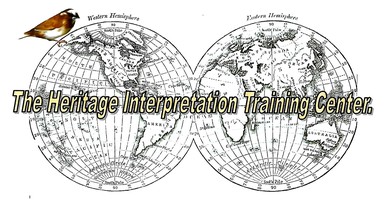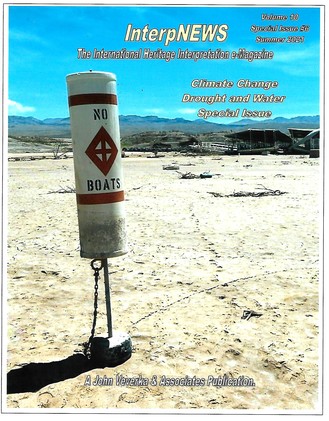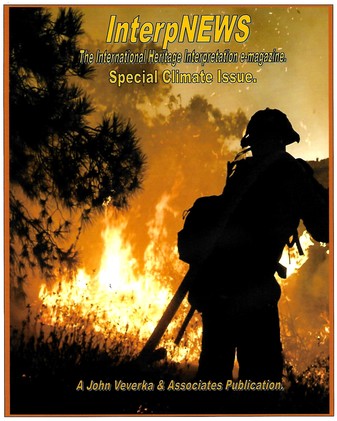John Veverka & Associates
Main menu:
- Home Page
- Our Range of Services
- Interpretive Coaching
- Interpretive Planning
- Interpretive Plan Outline
- Interpretive Training
- John Veverka Resume
- NEW Advanced Interp. Text Book
- InterpNEWS
- Library
- JVA NEWS, Courses and Updates
- Certificates
- Planning/Design of Interpretive Panels
- Interpretive Writing
- Interpretive Writing Course
- Interpretive Trails Course
- Interpretive Panels Course
- Introduction to Heritage Interpretation Course
- Interpretive Planning & Design of Marketing Brochures Course
- Training for Interp. Trainers
- Interpretive Exhibits Course
- Interpretive Master Planning Course
- Interpretive Planning for Scenic Byways.
- Critiquing and Coaching Interpretive Staff
- Advanced Interpretive Planning
- Interpretive Training Center Course Catalogue
- Interp. for International Visitors course.
- Interpretive Exhibits Evaluation
- Interp. Center Feasibility Analysis Course.
- Interp. for Commercial Tour Providers
- Interpretive Researchers Guide for Visitor Studies
- Interp. Planning for Historic Homes
- Heritage Interpretation Training Center
- Interpretive Planning for Botanical Gardens
- An introduction to planning and presenting live interpretive programs and tours for Museum/Heritage Site Docents and Volunteers.
- Developing Marketing Plans for Heritage & Tourism Sites and Attractions
- Interpretation Book Store
- Heritage Interpretation Resource Center
- Interpretive Planning for Historic Farms
- Developing Successful Partnerships
- Developing Interpretive Outreach Programs
- Community Interpretation Planning
- Interpreting Gravestones and Historic Cemeteries
- Using Interpretation to Accomplish Management Objectives.
- An Interpreters Guide for Survival Economics.
- Innovative Strategies for Interpretive Media and Services Planning.
- A Curators Guide for Developing Gallery Tours.
- Advanced Interpretive Writing - Technical Publications
- Advanced Interpretive Services for Managers, Supervisors, Team Leaders and Sr. Staff.
- Advanced Interpretation for Chiefs of Interp. - Interpretive Managers - Regional Interp. Specialists
- Interpreting Critical Issues.
- Developing Commercial Interpretation for Resorts, Cruise Ships, Campgrounds and Tourism Attractions.
- Planning and developing a new commercial tour guiding business.
- Interpretive Evaluation, Visitor Studies and Site Assessment Center
- The Center for Interpretive Planning Advancement & Excellence.
- Developing Requests for Proposals (RFPs)
- Planning and Facilitating Focus Workshops
- Planning for Interpretive Experiences
- 40 Years a Heritage Interpreter
- Interpretive Techniques - The Rest of the Story Course
- Certified Professional Interpretive Planner Certificate
- Certified Professional Interpretive Program
- Certified Professional Interpretive Writer certificate program.
- Visitor motives for attending interpretive programs.
- Exhibit Rehab Course
- Developing Training Workbooks & Manuals
- Planning for Railroad Museums and Sites.
- Climate Change Interpretation Course.
- When there's nothing left but the story - interp. storytelling.
- Interpreting Legends Myths and Fables
- InterpSHARE - Seminars 2022
- Interpreting Invasive Species
- Interpretiing Edible Insects
- Interpretaive Planning for Climate Change
- HITC Climate Crisis Resource Center
- PUP Members Only
- Starting a new Interp Consulting Business
- Panels 4 Week Course
- Interpretive Writing - 4 Week Course
- Marketing - 4 Week Course
- Intro to Interpretation - 4 Week Course
- Interp Climate Change - 4 Week Course
- Exhibit Rehab 4-Week Course
- Level 1
- Johns Interpreters Blog
- John Interpreters Blog 2
Interpretaive Planning for Climate Change

Updating or Creating
Park/Heritage Site Interpretive Master Plans
To Focus on Site Climate Changes Visible Impact
Boat docks sit empty on dry land, as Folsom Lake reservoir near Sacramento stands at only
18 percent capacity, as the severe drought continues in California on
September 17, 2015 İMark Ralston (AFP)
The need for developing interpretive master plans for parks, interpretive centers, nature preserves and related heritage site focusing on interpreting to visitors how climate change had, is, or can be affecting the natural history/ecology of the site is of key importance given the affect climate change is having today. This reflects the effects of droughts, dangerous heat impacts, affects in some area of hurricanes and flooding, and other climate change impacts on the natural environment that visitors can see and experience.
Thus, today's interpretive plans for sites may need to interpret to visitors such issues as:
- Impact of drought (reservoirs being low or "out of water" on communities, agriculture).
- Impact of drought on recreation (no water for boating, fishing, swimming).
- Impact of drought on electricity (reduced hydro power from dams).
- Water for migratory birds being reduced or eliminated.
- Impacts on local forests, prairies, grasslands, etc.
- Increased risks of fires,
- Mitigation and preparation for hurricanes or dangerous weather.
- Affects of hurricanes/tropical storms on habitats and ecosystems.
Updating or creating new interpretive programs, media or experiences as part of park/site interpretive master plans might include (in the site inventory and development process):
- New vistas or viewpoints to observe/interpret low water in reservoirs.
- New interpretation for hydro sites on effect of low water on electricity production.
- Interpretive panels for wetlands/migratory waterfowl sites on effect of low/no water in feeding
Areas.
- Re-writing interpretation for trails and boardwalk on impacts of drought, heat on ecosystems.
- Trail interpretation on affects of heat, drought on forest and grassland habitats.
- Interpretive panels or observation areas on waterways with diminished or low water flow.
- Interpretive panels of effect of heating and drought on ponds and lake life.
- Interpretive demonstrations using new weather stations for programs/exhibits.
- Affect of ocean salt water on freshwater habitats.
- New visitor center exhibits with a focus on the local (park/site) of climate change impacts.
You can start the course at any time and complete the course at your own pace - working on your individual interpretive master plaanning projects if desired with free consulting advice.
Course Units:
Unit One - Overview of the Model of Interpretive Planning and the models individual sections.
Unit Two - Updated inventory of new or existing climate change related sites, impacts or interpretive features/environmental habitats to be included in an updated park/site interpretive master plan.
Unit Three - Review of existing interpretive plan theme, sub-theme and objectives or - focus workshop to establish a new draft interpretive theme, objectives and interpretive storyline.
Unit Four - Updating interpretive messaging and objectives to reflect new and projected climate change impacts on your region and specifically your park, heritage preserve or heritage site.
Unit Five - Identify and map location of new climate change demonstration and interpretive experience areas within the park/heritage site.
Unit Six - Develop new interpretive site inventory and story develop form sets for how (and what to) interpret new or existing climate change demonstration sites.
Unit Seven - Develop an interpretive presentation on the short and long term affects of observable climate change impacts on areas of fire prevention, loss of ground water mitigation and resource management issues (depending on geographical location - West Coast vs. East coast heat waves vs. gulf state hurricanes and flooding).
Unit Eight - Develop a Climate Change interpretation outreach program for schools, civic organizations and government agencies.
Unit Nine- Develop an interpretive programs/services media and budget needs and update phasing for new climate change interpretation (wayside exhibits, trail interpretation, visitor center exhibits, live/conducted programs, outreach programs, etc.).
Unit Ten - finalize your updated interpretive master plan for your agency/organization.
The course structure and tuition includes:
- JVA Interpretive Master Planning e-Textbook
- Sex issues of the InterpNEWS Special Climate Change Issues
- Consultation via SKYPE or ZOOM with Prof. Veverka as needed.
- 2 CEUs (Continuing Education Unit Credits)
- Certificate of Completion from the Heritage Interpretation Training Center.
Two of our six resource issues:

Course tuition: $200.00 USD. Tuition can be paid via PayPal or Credit Card by clicking the PayNow button below. We will be notified of your payment received and get you started with the course right away. JV